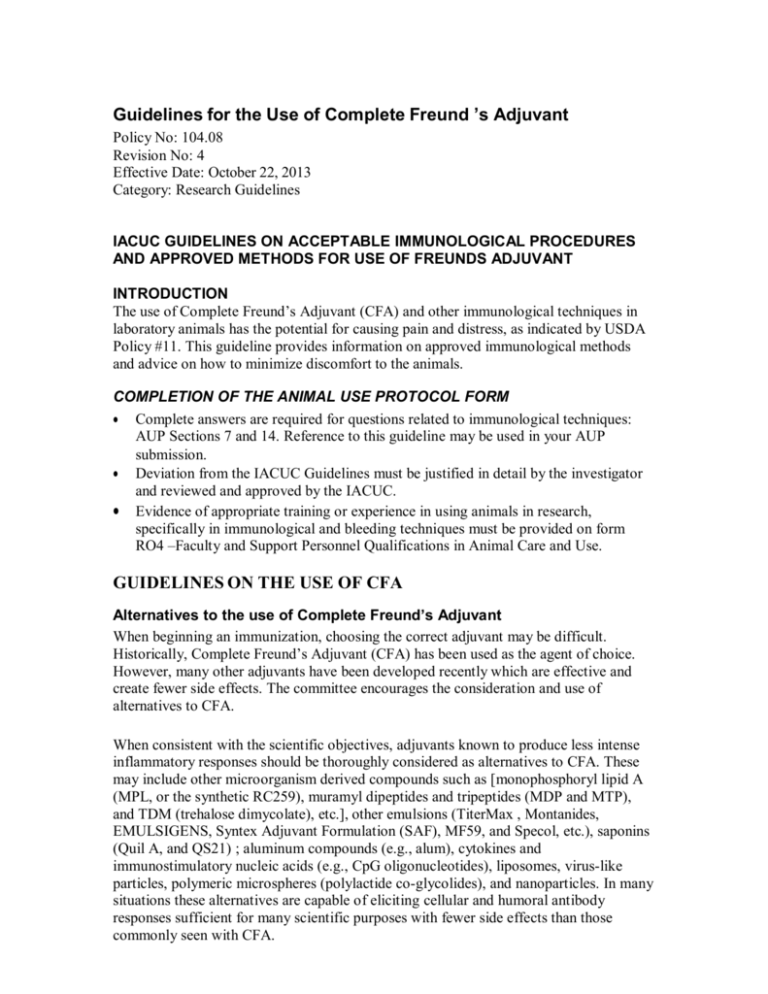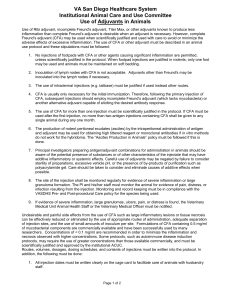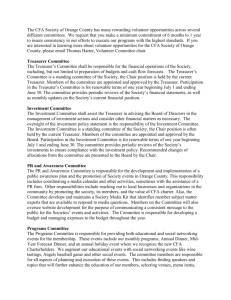Use of Complete Freund`s Adjuvant
advertisement

Guidelines for the Use of Complete Freund ’s Adjuvant Policy No: 104.08 Revision No: 4 Effective Date: October 22, 2013 Category: Research Guidelines IACUC GUIDELINES ON ACCEPTABLE IMMUNOLOGICAL PROCEDURES AND APPROVED METHODS FOR USE OF FREUNDS ADJUVANT INTRODUCTION The use of Complete Freund’s Adjuvant (CFA) and other immunological techniques in laboratory animals has the potential for causing pain and distress, as indicated by USDA Policy #11. This guideline provides information on approved immunological methods and advice on how to minimize discomfort to the animals. COMPLETION OF THE ANIMAL USE PROTOCOL FORM Complete answers are required for questions related to immunological techniques: AUP Sections 7 and 14. Reference to this guideline may be used in your AUP submission. Deviation from the IACUC Guidelines must be justified in detail by the investigator and reviewed and approved by the IACUC. Evidence of appropriate training or experience in using animals in research, specifically in immunological and bleeding techniques must be provided on form RO4 –Faculty and Support Personnel Qualifications in Animal Care and Use. GUIDELINES ON THE USE OF CFA Alternatives to the use of Complete Freund’s Adjuvant When beginning an immunization, choosing the correct adjuvant may be difficult. Historically, Complete Freund’s Adjuvant (CFA) has been used as the agent of choice. However, many other adjuvants have been developed recently which are effective and create fewer side effects. The committee encourages the consideration and use of alternatives to CFA. When consistent with the scientific objectives, adjuvants known to produce less intense inflammatory responses should be thoroughly considered as alternatives to CFA. These may include other microorganism derived compounds such as [monophosphoryl lipid A (MPL, or the synthetic RC259), muramyl dipeptides and tripeptides (MDP and MTP), and TDM (trehalose dimycolate), etc.], other emulsions (TiterMax , Montanides, EMULSIGENS, Syntex Adjuvant Formulation (SAF), MF59, and Specol, etc.), saponins (Quil A, and QS21) ; aluminum compounds (e.g., alum), cytokines and immunostimulatory nucleic acids (e.g., CpG oligonucleotides), liposomes, virus-like particles, polymeric microspheres (polylactide co-glycolides), and nanoparticles. In many situations these alternatives are capable of eliciting cellular and humoral antibody responses sufficient for many scientific purposes with fewer side effects than those commonly seen with CFA. Preconditions and limits on the use of Complete Freund’s Adjuvant Approval for the use of CFA will only be granted in cases where its use is scientifically justified. Complete Freund’s Adjuvant should be used only for the most problematic immunization situations. CFA must never be given either intravenously due to the risk of pulmonary embolism or in repeated doses. CFA must not be used in horses. Complete Freund’s Adjuvant (CFA) should usually be used when only small amounts of soluble immunogens are available. CFA is considered to be an emulsion consisting of equal volumes of CFA to antigen (1 part CFA or less to 1 part antigen). The administration of CFA may require the use of an appropriate analgesic. If large amounts of particulate or highly immunogenic immunogens are available, other adjuvants should be considered for use as an alternative. Although formulations of CFA containing 0.5 mg/ml mycobacterial concentration are commercially available and have been used successfully by many researchers, concentrations of < 0.1 mg/ml are recommended to minimize the inflammation and necrosis observed with higher concentrations (2). Use of greater concentrations than commercially available are not recommended unless scientifically justified and approved by the IACUC. Some routes of injection may potentially be less disruptive to the animal than other routes (e.g., subcutaneous injection vs. footpad administration). Whenever possible the least invasive methodology required to accomplish the experimental goal should be utilized. Intradermal and footpad injections should be avoided unless scientifically justified. Multiple injection sites must be separated by a distance sufficient to avoid coalescence of inflammatory lesions. A period of 2 weeks is recommended between subsequent inoculations with FIC (Freunds Incomplete Adjuvant). CFA should only be used once because repeated injections can lead to severe tissue reactions. In addition to the route of administration, the site of injection should be chosen with care to avoid areas that may compromise the normal movement or handling of the animal (e.g., intradermal injections in the scruff of the neck of a rabbit). Recommended Immunization Site # and Injection Volumes for Injection of Immunogen/Depot Forming Adjuvant Species Route of Mice Rats Guinea Pigs Rabbits Administration Subcutaneous 0.1 ml/site 0.1 – 0.2 ml/site 0.1 - 0.2 ml/site 0.1 ml/site (SC) 1 sites max 2 sites max 2 sites max 4 sites max** Intramuscular (IM) * * Intraperitoneal (IP) 0.1 0.1 1 site max** 1 site max** Intradermal (ID) Footpad *00 * * * * 0.25 ml/site 1 site without justification, 2 sites max** Chickens Sheep/Goats 0.25-0.5 ml/site Max of 0.25 1 site max ml/site. 0.5 ml total. Site # according to protocol ** 0.25-0.5 ml/site Max # of 0.25 1 site max ml/site. 0.5 ml total. Site # according to protocol** * * * 0.025-0.05 ml/site * * * Not applicable 5-8 sites ** 0.05 0.1 1 site max** 1 site max** * Not recommended ** Only when justified * * INJECTION TECHNIQUE The skillful preparation and delivery of the antigen is critical to the success of the immunization and comfort of the animal. The injection site(s) must be shaved and prepared with appropriate antiseptic to ensure asepsis and minimize postinjection complications. If necessary animals, especially rabbits, may be sedated prior to injection of Freunds Adjuvant. Please consult the Animal Resources veterinary staff for advice on anesthetic/sedative combinations and methods of injecting or bleeding. Be sure to deposit the adjuvant in the correct volume, route and site(s). Improper delivery results in tissue necrosis and failure. The formulation strength of CFA is important in determining the degree of reaction and side effects. Training of Personnel An important aspect in immunization procedures is the utilization of skilled, competent, technical staff experienced in the handling of the species being used and in performing the technique. They must be knowledgeable and capable of recognizing signs of distress in all injected animals, and be responsible for taking action when necessary. Preparation of Injection Site The area must be clipped thoroughly and prepared aseptically. A Betadine or Nolvasan Scrub is suitable for disinfection of the skin, followed by wiping the area with isopropyl alcohol pads. The skin should then have either Betadine or Nolvasan solution applied to the skin prior to inoculation. This has the dual purpose of preventing infection at injection sites and facilitating monitoring of the site. Intradermal Route Sound scientific evidence and justification must be available if the intradermal route of injection of CFA is to be used. Frequent ulceration and infections can occur at the site of intradermal injections with CFA. In rabbits, volumes of inoculum in excess of 0.05 ml. (50 microliters) per site should not be used. The location of the site(s) should be carefully selected so as to prevent mutilation. A minimal number of sites should be selected, and the distance between each site be maximized. The intradermal route is inappropriate in the mouse, nor is it recommended in other rodents. Subcutaneous Route In guinea pigs, up to a total volume of 0.4 ml (400 microliters) of inoculate may be injected subcutaneously dorsally in the neck, divided into two sites. In rabbits, the site of choice is the interscapular region (between the shoulder blades skin on the dorsum (back), avoiding the neck where the rabbit is restrained or handled, administering up to 0.1 ml of inoculum (100 microliters) per site, to a maximum of four sites. The distance between sites should be maximized. In the mouse, up to 0.1 ml (100 microliters) may be administered in the neck region. Intramuscular Route Sound scientific evidence and justification must be provided if the intramuscular route of injection of CFA is to be used. In rabbits, intramuscular injections of CFA may be administered in the thigh muscle; up to 0.5 ml (500 microliters), preferably in one site. If two sites are used no more than 0.25 ml can be administered per site. The use of two site instead of one site must be justified. Intramuscular injection of CFA is not recommended for small laboratory animals such as rats, mice, hamsters, gerbils, etc. For larger animals such as cats and dogs, up to 1 ml of CFA injected into the thigh muscles is acceptable. In livestock such as pigs, cattle, sheep and goats, the intramuscular route is acceptable. In poultry, CFA may be injected in the pectoralis (breast) or neck muscle. The leg in poultry should be avoided since it can lead to lameness. Chickens should be at least seven weeks of age before the IM route is used. Intraperitoneal Route The intraperitoneal route for injection of CFA is permitted in mice and rats only. CFA should be administered only once, and be limited to maximum volumes of up to 0.1 ml (100 microliters). Intravenous Route Intravenous injection of Freund’s Complete Adjuvant is NOT PERMITTED. Footpad Injection CFA must not be injected in the feet of rabbits. Footpad injection of CFA in rodents is not permissible unless there is scientific evidence indicating this route is essential as a specific requirement for the production of immune response. In rats and mice, only one footpad may be used. The concomitant use of appropriate analgesics is required if footpad injections are used. Animals should be maintained on soft bedding and not on wire bottomed cages. The IACUC recommends against the injection of complete Freund’s adjuvant into the footpad unless the PI can demonstrate that the antigen is a poor immunogen by other routes. If the footpad injection is approved by the IACUC, the following conditions must strictly be observed: a. one hind footpad only may be injected; b. the volume of material to be injected into the footpad must not exceed 0.05 ml for a mouse and 0.1 ml for a rat. c. although the first injection may utilize complete Freund’s, subsequent (booster) injections must be only of incomplete Freund’s adjuvant or saline and must be made higher on the leg in the region of the semitendenosus and semimembranosus muscle groups. d. the concomitant use of appropriate analgesics is required. OBSERVATION OF INJECTION SITES The injection sites(s) must be observed by the investigator or his/her delegate, a minimum of three times per week, for four weeks after each injection. If an abscess or ulceration develops at any injection site, it must be reported through established channels, e.g., the animal resources supervisor or veterinarian, and must receive appropriate veterinary treatment. Such lesions should be inspected at least three times per week by the investigator or his/her designate, until all lesions are healed. For more information please see the Canadian Council on Animal Care, CCAC Guidelines on Acceptable Immunological Procedures (http://www.ccac.ca/en/CCAC_Programs/Guidelines_Policies/POLICIES/IMMUNO.HTM) REFERENCES: 1. Amyx, H.L. Control of animal pain and distress in antibody production and infectious disease studies. J Am Vet Assoc: 191:12871289. 1987. 2. Broderson, J.R. A retrospective review of lesions associated with the use of Freund's adjuvant. Lab Anim Sci 39:400405, 1989. 3. Chapel, H.M. and August, P.J. Report of nine cases of accidental injury to man with Freund's Complete Adjuvant. Clin Exp Immunol 34:358541, 1976. 4. Hunter, R., Strickland, F. and Kezdy, F. The adjuvant activity of nonionic block copolymer surfactants, I. The role of hydrophilelipophile balance. J Immunol 127:12441250, 1981. 5. Hunter, R.L. and Bennett, B. The adjuvant activity of nonionic block polymer surfactants, II. Antibody formation and inflammation related to the structure of triblock and octablock copolymers. J Immunol 133:31673175, 1984. 6. Hunter, R.L., and Bennett, B. The adjuvant activity of nonionic block polymer surfactants, III. Characterization of selected biologically active surfaces. Scand J Immunol 23:287300, 1986. 7. Hunter, R.L., Bennett, B., Howerton, D., Buynitzky, S., and Check, I.J. Nonionic block copolymer surfactants as immunological adjuvants: mechanisms of action and novel formulations. In Immunological Adjuvants and Vaccines. G. Gregoriadis, A.C. Allison, G. Poste, editors. Plenum Press, New York, pp. 133144, 1989. 8. Johnston, B.A., Eisen, H. and Fry, D. An evaluation of several adjuvant emulsion regimens for the production of polyclonal antisera in rabbits. Lab Animal Sci 41(1):1521, 1991. 9. Kenney, J.S., Hughes, B.W., Masada, M.P. and Allison, A.C. Influence of adjuvants on the quantity, affinity, isotype and epitope specificity of murine antibodies. J Immun Methods 121:157166, 1989. 10. Kittell, C.L., Banks, R.E. and Hadick, C.L. Raised skin lesions on rabbits after immunization. Lab Animal 20(7):1619, 1991. 11. Lew, A.M., Anders, R.F., Edwards, S.J. and Langford, C.J. Comparison of antibody avidity and titre elicited by peptide as a protein conjugate or as expressed in vaccinia. Immunology 65(2):311413, 1988. 12. McGuill, M.W. and Rowan, A.N. Refinement of monoclonal antibody production and animal wellbeing. ILAR News 31:711, 1989. 13. Mizisin, A.P., Wiley, C.A., Hughes, R.A. and Powell, H.C. Peripheral nerve demyelination in rabbits after inoculation with Freund's complete adjuvant alone or in combination with lipid haptens. J Neuroimmunol 16(3):381395, 1987. 14. Neimi, S.M., Fox, J.G., Brown, L.R. and Langar, R. Evaluation of ethylenevinyl acetate copolymer as a noninflammatory alternative to Freund's complete adjuvant in rabbits. Lab Animal Sci 35(6):609612, 1985. 15. Ribi, E., et al. A new immunomodulator with potential clinical applications: monophosphoryl lipid A, a detoxified endotoxin. Clin Immunol Newsletter 6:3336, 1985. 16. Ribi, E., Cantrell, J., Feldner, T., Myers, K. and Peterson, J. Biolofical activities of monophosphoryl lipid A. In Levie, L., Bonventre, P.F., Morella, J.A., Silver, S.D., and Wu, H.C. (eds.) Microbiology 1986. American Society of Microbiology, Wash., D.C. p. 9, 1986. 17. Schiefer, B. and Stunzi, H. Pulmonary lesions in guinea pigs and rats after subcutaneous injection of Complete Freund's Adjuvant or homologous pulmonary tissue. Zbl Vet Med A 26:110, 1979. 18. Ulrich, J.T., Masihi, K.N. and Lange, W. Mechanisms of nonspecific resistance to microbial infections induced by trehalose dimycolate (TDM) and monophosphoryl lipid A (MPL). Advances in the Biosciences, Vol. 68, 1988. 19. Warren, H.S., Vogel, F.R. and Chedid, L.A. Current status of immunological adjuvants. Annu Rev Immunol 4:369388, 1986. 20. Coenraad F. M. Hendriksen, ILAR (2005) vol 46 no 3, Immunization Procedures and Ajuvant Products, Pp 227307. 21. ARAC Guidelines, Guidelines for the Research Use of Adjuvants, http://oacu.od.nih.gov/ARAC/Adjuvants_111407F.pdf




